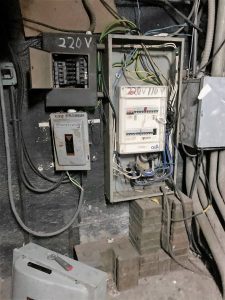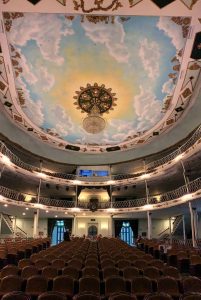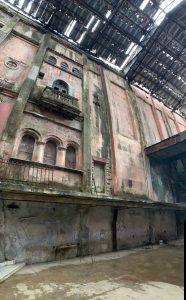Cuba Reflections
Webster has several definitions of “community”: a people with common interests living in a particular area, joint ownership or participation, or a group linked by a common policy. All three of these apply to Cuba, especially for those individuals and groups involved in the performing arts that ASTC members met during the 2019 Forum in Havana.
In spite of the Cuban government’s layers of bureaucracy, byzantine and conflicting rules, and well-documented corruption, the performing and visual arts thrive in this country (or at least in Havana, which was the focus of the ASTC Forum.) What was most striking was the ability of artists and managers, in the performing and visual arts, to create self-supporting “communities” that allow for much freedom of expression, even under what we in the US would consider a repressive regime.
In studies of great contrast, ASTC members saw a grand, 19th century Viennese-style opera house (the Gran Teatro, home of the Cuban National Ballet and Opera), abandoned, open-to-the-sky movie theatres (because the roofs had collapsed), and other venues in various conditions. Members met and conversed (often quite freely) with government officials, venue managers, artistic directors, artists, and performers: How were the arts funded? How are venues restored or new ones built? Who are the architects and/or consultants involved in such projects? Who drives the programming of a space? Where do you get your materials?
In Havana, there are two governmental ministries that oversee the restoration and/or programming of venues for the performing arts (we weren’t made aware of any brand-new venues in construction or planning). The Office of City Historian oversees renovations to existing sites that have cultural significance (the Gran Teatro is the prime example), while the Ministry of Culture supports smaller upgrades and repairs to existing spaces, as well as providing funding for events and performances, and the salaries for artists, performers, technicians, managers, etc.
At this point it should be noted the “salaries” paid by the government to all workers in Cuba are essentially the same, anywhere from $20 to $100 US per month, with the majority in the lower range. While there is “free” health care, education, housing, and public transportation, Cuba is, at its core, a very poor Caribbean country. Government policies and economic controls (and US sanctions) keep everyone “equally poor.” Enterprising Cubans do garner additional income from tips working in the tourist industry, independent side jobs (the “underground economy”), or in government sanctioned small businesses such as family run restaurants, cafes, B&Bs, small shops, etc.

The electrical panels at Teatro National show age and neglect in a city where money is hard to come by. Peter Scheu, ASTC
All venues ASTC members toured had areas which could be improved in one way or another. The Gran Teatro had a stunning baroque exterior and grand lobbies, and classic European style horseshoe seating, but was equipped with older knock-off lighting and sound equipment. Access to persons with disabilities was nonexistent, flooring in the seating area was uneven and presented trip hazards.
The Teatro Nacional de Cuba, originally designed in the 1950s to be Cuba’s performing arts face to the world, and a Batista “vanity project,” was described by one ASTC member as “the theatre of a hundred ways to die.” Exposed electrical wiring, rigging that hadn’t been updated since the late 50s, dark and dank spaces, cobwebs everywhere (even on working catwalks), inoperable stage lifts, dressing spaces that resembled 1960s gas station restrooms, and a literal stream running though the basement.

Teatro Marti is a beautiful European style theatre which has been renovated in the recent past. Photo by Peter Scheu, ASTC.
The other operating venues members visited, while in better condition than the Teatro Nacional, were all poorly equipped with ancient or aging systems, no accommodations for persons with disabilities, and basically held together with bailing wire and duct tape (no real gaffer’s tape here). It is clear Cuban performers work in difficult conditions, with most venues suffering from a lack of basic maintenance.
The performers ASTC members met, while enjoying their talents in both dance and music, were world-class. Some were working within government sanctioned groups; some were totally independent to have more freedom of artistic expression.
Members learned about surviving as an artist, securing funding any way possible, by hook or by crook, keeping venues alive, and a host of other cultural and political issues affecting the performing arts. Members may have not seen the latest theatre production technology, or grand experiments in new, cutting edge venue design, as are typically toured at ASTC forums. We theatre consultants often get caught up in these priorities. While there was a certain amount of culture shock experienced by members in Havana, one thing became apparent. In the US, “Community Theatre” is sometimes looked down upon, with amateur actors motivated by passion and good intentions. In Havana, the venues seemed almost inconsequential, because it is clearly the people, both audiences and artists, creating their “community” and bringing life force to the performing arts.
By Peter Scheu, ASTC
Disclaimer: Any views or opinions expressed in this article are solely those of the author and do not necessarily represent those of the American Society of Theatre Consultants. This article is for general information only and should not be substituted for specific advice from a Theatre Consultant, Code Consultant, or Design Professional, and may not be suitable for all situations nor in all locations.



